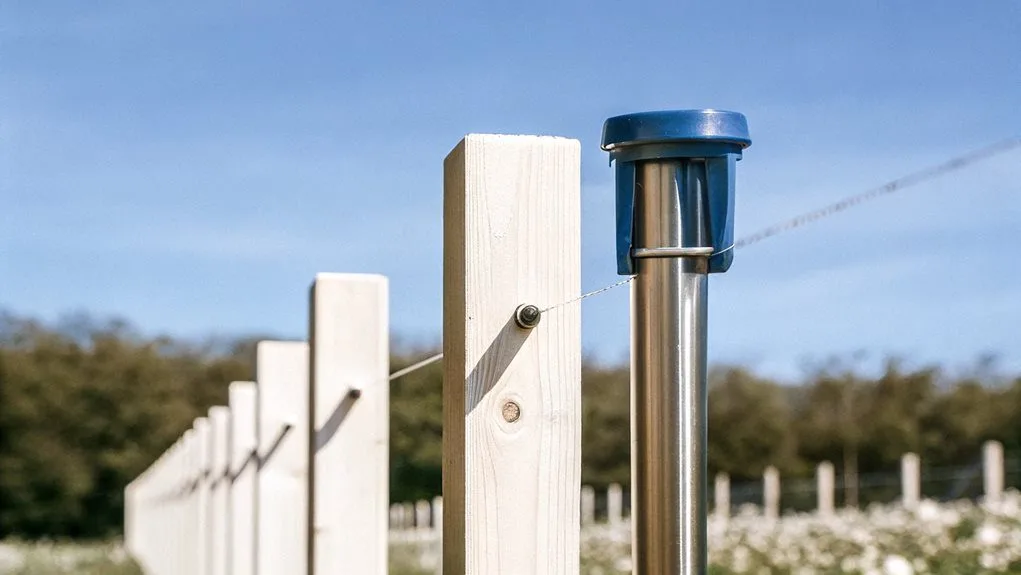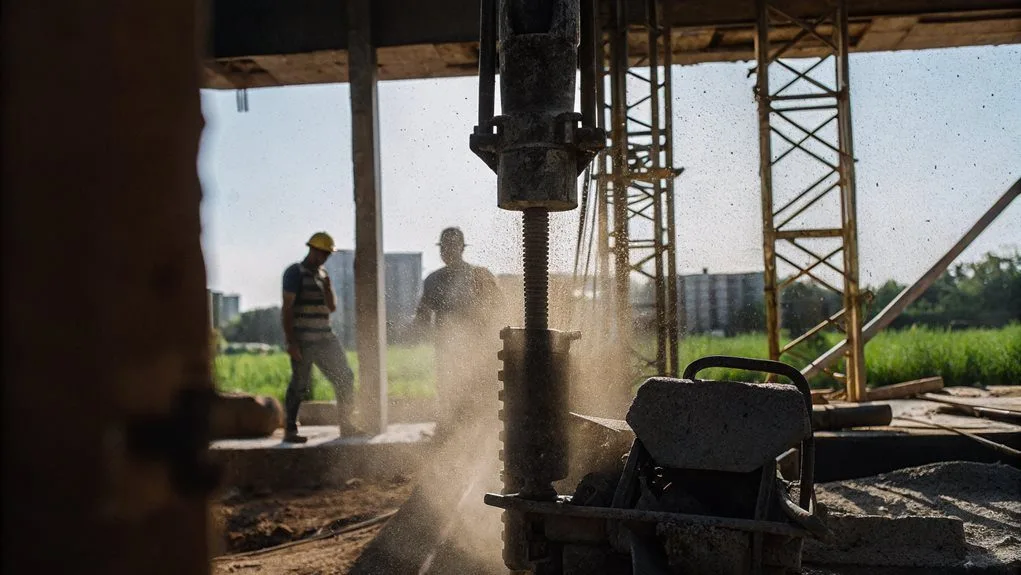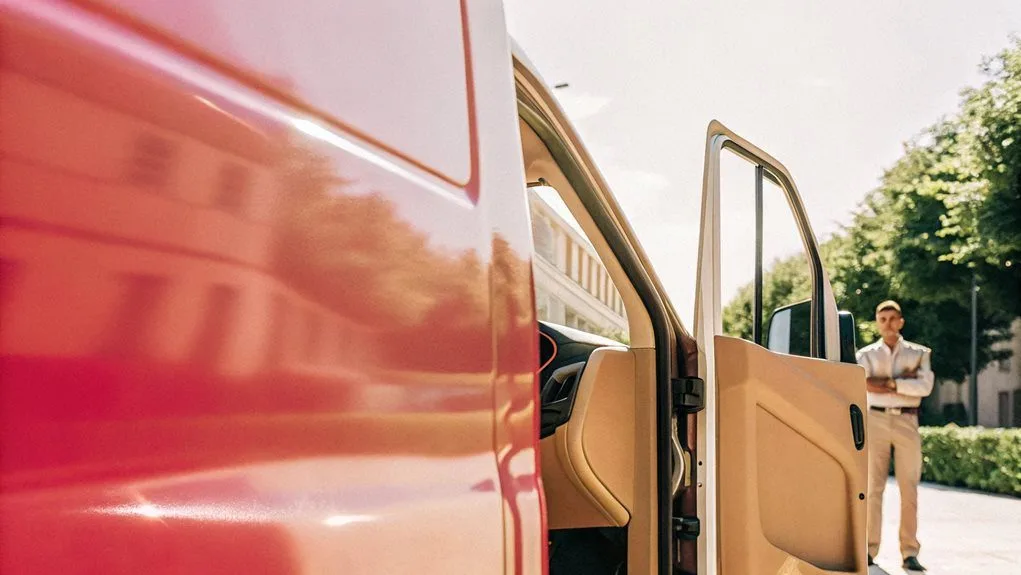Absolutely, a boom lift can certainly handle tree trimming tasks! Forget about wobbly ladders that make your knees weak—with a boom lift, you can reach those high branches without risking your life, which is definitely a win-win situation. These machines are versatile, efficient, and significantly safer than traditional methods, allowing operators to access difficult angles and heights with greater stability and control.
However, it’s crucial not to forget about weight limits and safety protocols, or you might find yourself in a rather serious situation. Always ensure the equipment is properly inspected, operators are trained and certified, and all safety guidelines are followed meticulously. The right boom lift selection depends on factors such as working height requirements, terrain conditions, and the specific demands of your tree trimming project.
Key Takeaways
- Boom lifts provide safe access to high branches, making them ideal for tree trimming tasks.
- They offer excellent maneuverability on uneven terrain, enhancing job efficiency.
- With various models available, boom lifts can handle different tree heights and branch thicknesses.
- Their aerial lift design is a safer alternative to traditional ladders for elevated work.
- Built-in safety features, like harnesses and anchor points, ensure protection during tree trimming operations.
Advantages of Using Boom Lifts for Tree Trimming
Regarding tree trimming, using a boom lift is essentially like advancing your professional capabilities. You’ll reach considerable heights, accessing those stubborn branches without feeling as though you’re climbing an Everest-sized tree. No more two-person teams struggling to pass equipment—seriously, who’s time for that? With boom lifts, you get quick access and manoeuvrability, even on uneven terrain. Aerial lifts are designed to enhance job efficiency and safety, making your work much more productive. Plus, you won’t feel like a human pretzel after a long day. And let’s not forget the versatility. Boom lifts aren’t just for trimming; they’ll assist with pruning and even tree removal. With various models available, you’re improving efficiency whilst saving rands—yes, please!
Safety Features of Boom Lifts
So, you think operating a boom lift is just a walk in the park? With those thorough safety systems, you’d better be prepared to strap up—literally. And let’s not forget about those pesky regular maintenance protocols; they’re not just suggestions! Understanding the essential boom lift safety tips can significantly mitigate risks while working at heights. Before starting a lift, it’s crucial to conduct a thorough pre-lift inspection to ensure everything is in proper working order.
Comprehensive Safety Systems
Regarding using a boom lift for tree trimming, safety isn’t just a buzzword—it’s your best friend. You wouldn’t ignore a “weight limit” sign at an all-you-can-eat buffet, right? So, stick to those manufacturer specs! Properly utilizing the object detection sensors enhances your awareness of surroundings and minimizes risks while operating.
Regular inspections? Yeah, they’re your pre-lift pep talk. Make sure those sensors are alive and kicking; they’ll keep you from tipping like that one mate after too many drinks. It’s crucial that the firm ground beneath the lift ensures stability to avoid collapse.
And let’s not skip training—you don’t want to become the headline for the wrong reasons.
Remember, overloading isn’t just frowned upon; it’s a recipe for disaster.
Fall Protection Measures
When you’re up in a boom lift, you don’t just sit back and enjoy the view—fall protection’s got to be your top priority.
Seriously, when you’re dangling above the ground, wouldn’t you want to feel secure?
The Department of Employment and Labour requires you to use a full-body safety harness, not some flimsy body belt.
Why take that risk?
Those safety harnesses are designed to spread out forces, so if you take a tumble, your body has a fighting chance. Fall protection is required when operating a lift—don’t overlook this critical safety measure!
Boom lifts even come with built-in anchor points for reliable fall protection systems.
Fancy, right?
And let’s not forget lanyards; they’re your lifeline, literally.
So, gear up!
You don’t want to be that person who forgets the basics and turns a tree trimming job into a circus act.
Regular Maintenance Protocols
Maintaining your boom lift isn’t just a good idea; it’s essential for survival—yours, specifically. Think about it: would you trust a wobbly ladder? Exactly.
Start your day with a walk-around inspection. Look for any wear or damage, because, spoiler alert, that stuff matters.
Follow the manufacturer’s maintenance schedule like it’s your favourite TV programme.
Regular fluid checks? Yes, please! Make sure everything’s topped off, including those tyres—nobody wants a flat in the air.
And don’t forget: test those safety features. Emergency stops? Yeah, they better work!
If you’re not a pro, get one. Otherwise, you might just find yourself in a predicament that your boom lift really can’t handle.
Safety’s not just an option; it’s your lifeline.
Types of Aerial Lifts for Tree Maintenance
A whole range of aerial lifts is just waiting for you regarding tree maintenance.
Got tall trees? You’ll want a boom lift for those high reaches.
For towering trees, a boom lift is your go-to for soaring heights!
Need to manoeuvre through compact spaces? Enter the spider lift! It’s like a yoga expert for tight spots.
If you’re lifting materials, a telehandler can be your best friend, combining crane and forklift capabilities.
Scissor lifts are perfect for reliable elevation, indoors or out.
And let’s not forget specialised lifts, designed for those ridiculously dense woodlands.
So many choices, and you’re still wondering which one to pick? Don’t worry; you’re not alone!
Just imagine: finally tackling that overgrown garden without climbing up like a vervet monkey on caffeine!
Key Considerations for Choosing a Boom Lift
When picking a boom lift, don’t just guess how high you need to go—seriously, it’s not like you’re trying to reach the top shelf at home.
You can’t ignore the terrain; if you’re working on a steep hill, a sturdy tracked lift might be your best buddy, not some flimsy model.
And let’s not forget load capacity—because your tree trimmer shouldn’t double as a weightlifter unless you want an overhead horror show!
Working Height Requirements
Choosing the right boom lift for tree trimming isn’t just about picking the first shiny machine you see, trust me. You wouldn’t want a tiny lift when you’re battling a 15-metre oak, right?
Most jobs demand heights of 9 to 18 metres, so check those specs! Some straight boom lifts can soar to 57 metres.
Remember, the working height‘s usually about 1.8 metres taller than the platform height—thank you, reach!
And if you’re in an industrial zone, aim for 14 to 18 metres.
It’s not just about looking cool at heights; you need flexibility and stability.
Terrain and Stability
So, you’ve got the working height sorted—now it’s time to think about where you’re actually lifting that shiny boom lift. Are you planning to conquer the Drakensberg? Not quite, but slopes can be tricky!
Boom lifts aren’t fans of high inclines, thanks to their high centre of gravity. Just imagine tipping over—yikes!
And let’s not forget mud or loose gravel; they’re not your mates either.
You want stability, right? Outriggers can help level things out, but you’ll need to keep an eye on those conditions.
Driving too fast on uneven ground? That’s a bad idea. You wouldn’t speed through a pothole-filled road, would you?
A little planning can save you from a whole lot of headaches!
Load Capacity Considerations
You’ve got your height sorted, but what about the weight?
Seriously, you can’t just throw a party up there with all your tools and mates.
The load capacity of your boom lift is essential—it’s that magical number reflecting how much it can handle.
Most of these lifts go up to 227 kg, but you’ll need to do some maths.
Add yourself, your gear, and those fancy tools you swear by.
And let’s be real; don’t push it too close to the limit. Safety margins exist for a reason!
Choose a model that fits your needs—whether it’s telescopic or articulating.
Because no one wants to flirt with disaster when you’re just trying to do some tree trimming!
Proper Training and Safety Protocols
Although it might seem like a good idea to hop into a boom lift without any training, let’s be real: that’s a fast track to trouble.
Seriously, who needs to know how to operate machinery, right? You wouldn’t jump into a car without a licence, would you?
Proper training is key. You’ve got to know the safety protocols, inspect your boom lift, and make sure you’re certified.
Proper training is essential; knowing safety protocols and inspecting your boom lift can mean the difference between safety and disaster.
You’ll want to avoid any “whoops” moments!
Wearing a helmet and safety belt isn’t just fashionable—they actually protect you.
And hey, those annoying pre-use inspections? They can save your life.
So, let’s keep it smart and safe.
After all, nobody wants to be the one who turned a routine tree trim into a rescue mission!
Applications Beyond Tree Trimming
After you’ve got the whole boom lift safety thing down—because, let’s be real, nobody wants to end up on the evening news—it turns out there’s a lot more you can do with these machines than just trim trees.
Need to paint a skyscraper? A boom lift’s your mate.
It’ll also take care of hanging those fancy lights at your events, so your cousin’s wedding doesn’t look like a garage sale.
And, let’s not forget, they’re lifesavers for municipal workers trying to fix those tricky power lines.
Sure, it’s great for high fruit-picking, but let’s be honest—who doesn’t want to feel like an acrobat whilst doing it? A boom lift’s a must-have for real-world superheroes like you!
Conclusion
So, next time you think about tree trimming, remember: a boom lift isn’t just a fancy toy! It’s your trusty sidekick in the battle against wild branches. Sure, you’ll need some training—because no one wants to reenact a slapstick comedy scene gone wrong. Just imagine yourself, up high, like some superhero tackling the leafy menace. With safety features that don’t just exist for decoration, you’re not just trimming trees; you’re elevating your expert status! Who wouldn’t want that?






